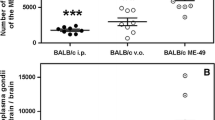Abstract
BALB/c mice infested three times with nymphs or larvae of Ixdoes ricinus ticks do not acquire resistance as assessed by evaluation of both tick attachment and the weight of engorged nymphs or larvae. Tick challenge causes a gradual increase in total IgE antibody production from the first to the third infestation. Anti-tick IgG antibodies are never detected. When the mice are treated with anti-interleukin-4 (anti-IL-4) or anti-interferon-gamma (anti-IFN-γ) monoclonal antibodies (mAbs) 1 day before each infestation, they produce fewer or more IgE antibodies, respectively. No effect is observed on IgG antibodies. In IL-4-deficient mice, no IgE or IgG antibody is produced. However, these treatments and the use of IL-4-deficient mice have no negative effect on either tick attachment or the weight of engorged nymphs or larvae. Treatment with anti-IL-4 mAb and the use of IL-4-deficient mice inhibits and abolishes the switching of IgE, respectively, but these are apparently not sufficient to shift the response toward Th1 cells.
Similar content being viewed by others
Author information
Authors and Affiliations
Additional information
Received: 18 July 1997 / Accepted: 12 November 1997
Rights and permissions
About this article
Cite this article
Christe, M., Rutti, B. & Brossard, M. Susceptibility of BALB/c mice to nymphs and larvae of Ixodes ricinus after modulation of IgE production with anti-interleukin-4 or anti-interferon-γ monoclonal antibodies. Parasitol Res 84, 388–393 (1998). https://doi.org/10.1007/s004360050415
Issue Date:
DOI: https://doi.org/10.1007/s004360050415




